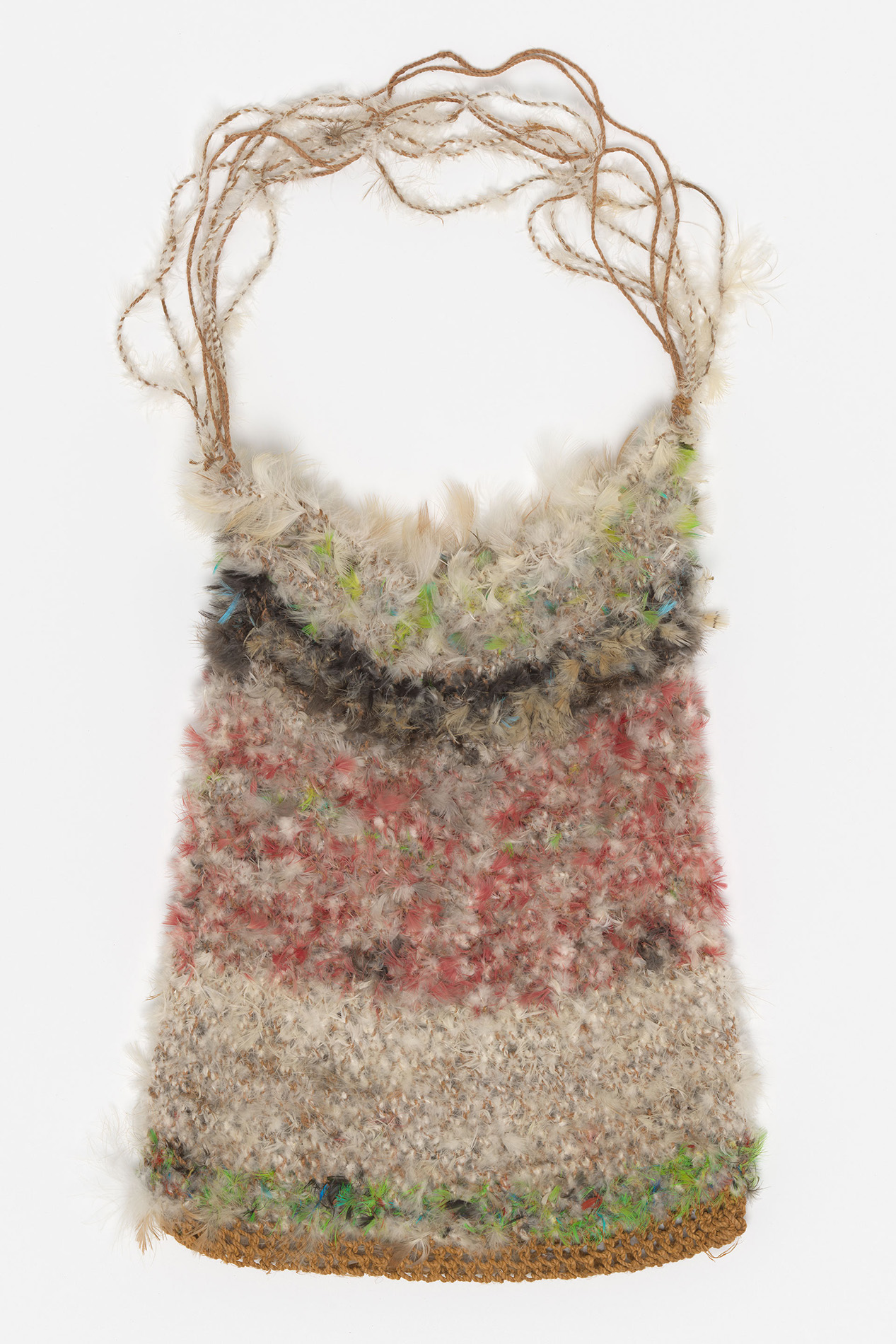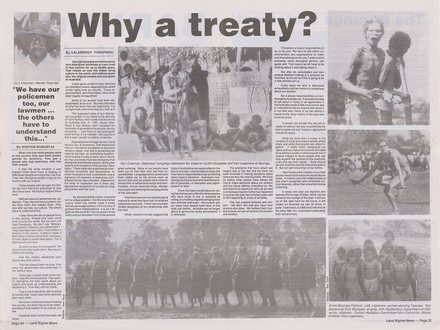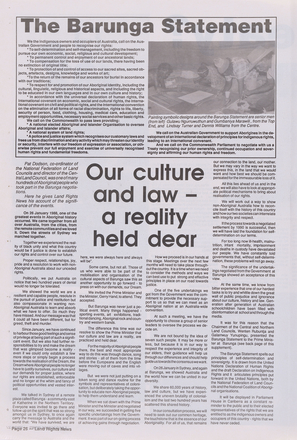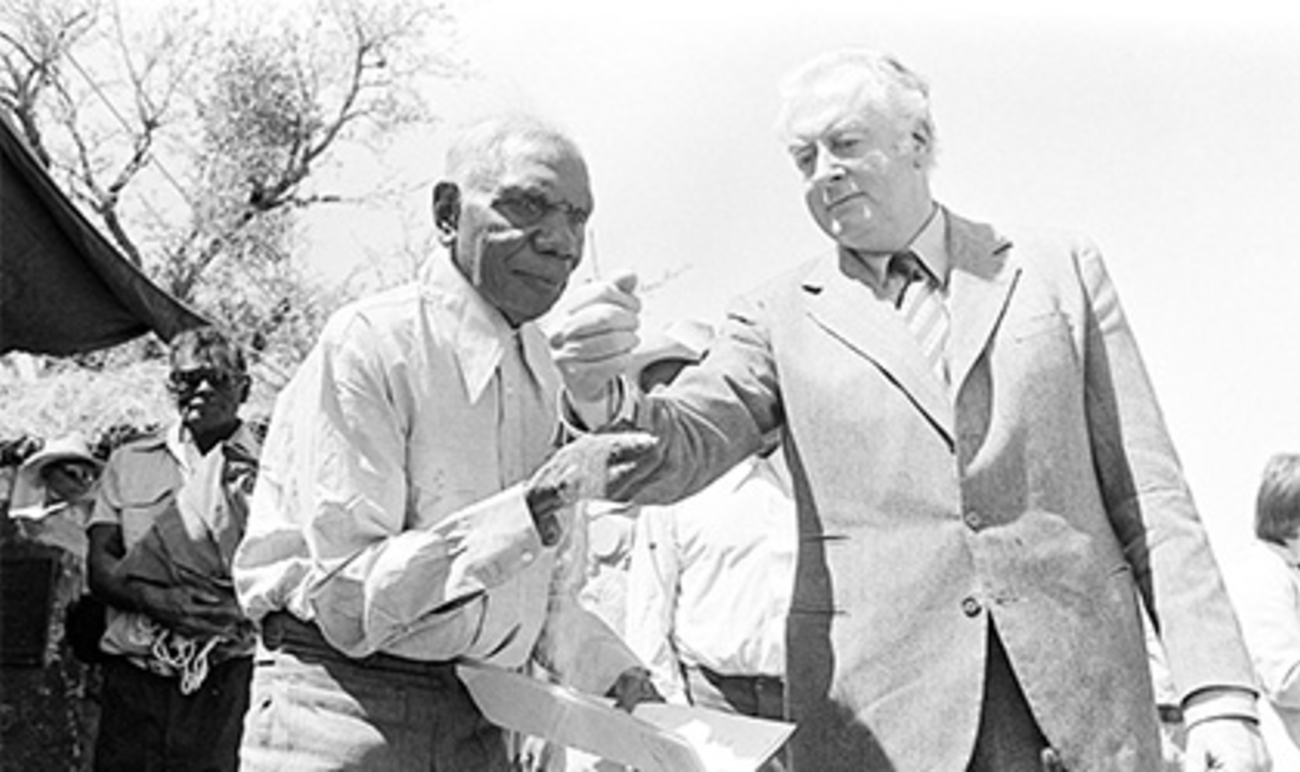Please note: Under Yolngu mourning protocols, the names of people who have passed should not be spoken for a period of time. Marrirra Marawili passed away in February 2018, and we respectfully request that his name is not spoken aloud.
The Barunga Statement is one of several significant painted documents that Aboriginal people have presented to the Australian Government.
Painted during the 1988 Barunga Sport and Cultural Festival, it was the culmination of years of engagement and discussion between Aboriginal groups in the Northern Territory and the Australian Government.
The statement combines Aboriginal symbolism from northern and central Australia and a translation of these into English language text, signalling collaboration and communication across cultures and languages.
‘The dot-style painting of Central Australia and the cross-hatching paintings of Northeast Arnhem Land show that Aboriginal people of different countries, speaking different languages, can unite in the same struggle.’ — Galarrwuy Yunupingu1
The Northern and Central Land Councils presented the Statement to former prime minister Bob Hawke as a declaration of the aspirations of ‘the Indigenous owners and occupiers of Australia’ and a request to the Australian Government and people to ‘recognise our rights’.
Read the full text of the Barunga Statement
Barunga Statement
We, the Indigenous owners and occupiers of Australia, call on the Australian Government and people to recognise our rights:
- to self-determination and self-management, including the freedom to pursue our own economic, social, religious and cultural development;
- to permanent control and enjoyment of our ancestral lands;
- to compensation for the loss of use of our lands, there having been no extinction of original title;
- to protection of and control of access to our sacred sites, sacred objects, artefacts, designs, knowledge and works of art;
- to the return of the remains of our ancestors for burial in accordance with our traditions;
- to respect for and promotion of our Aboriginal identity, including the cultural, linguistic,
- religious and historical aspects, and including the right to be educated in our own languages and in our own culture and history;
- in accordance with the universal declaration of human rights, the international covenant on economic, social and cultural rights, the international covenant on civil and political rights, and the international convention on the elimination of all forms of racial discrimination, rights to life, liberty, security of person, food, clothing, housing, medical care, education and employment opportunities, necessary social services and other basic rights.
We call on the Commonwealth to pass laws providing:
- A national elected Aboriginal and Islander organisation to oversee Aboriginal and Islander affairs;
- A national system of land rights;
- A police and justice system which recognises our customary laws and frees us from discrimination and any activity which may threaten our identity or security, interfere with our freedom of expression or association, or otherwise prevent our full enjoyment and exercise of universally recognised human rights and fundamental freedoms.
We call on the Australian Government to support Aborigines in the development of an international declaration of principles for indigenous rights, leading to an international covenant.
And we call on the Commonwealth Parliament to negotiate with us a Treaty recognising our prior ownership, continued occupation and sovereignty and affirming our human rights and freedom.
The artists
| Galarrwuy Yunupingu AM, 1948, Gumatj people |
| Marrirra Marawili, c.1937-2018, Madarrpa people |
| Bakulangay Marawili, 1944-2002, Madarrpa people |
| Djambawa Marawili AM, 1953, Madarrpa people |
| Dula Ngurruwuthun, 1936-2001, Munyuku people |
| Djewiny Ngurruwuthun, c. 1940-2001, Munyuku people |
| Wenten Rubuntja AM, c. 1926-2005, Arrernte people |
| Lindsay Turner Jampijinpa, 1951-2009, Warlpiri people |
| Mr D Williams Japanangka, 1948-2013, Warlpiri people |
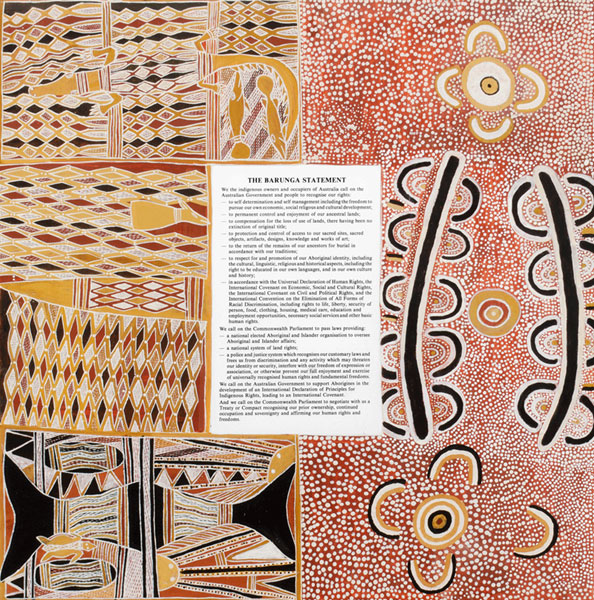
The Barunga Statement 1988. Natural pigments on composition board with attached printed text on paper presented by the Central Land Council and Northern Land Council in 1988. Gifts collection, Parliament House Art Collection.
The Barunga Statement 1988. Natural pigments on composition board with attached printed text on paper presented by the Central Land Council and Northern Land Council in 1988. Gifts collection, Parliament House Art Collection.
Saltwater country
The left-hand side of the Barunga Statement was completed by Yolngu men from northern Australia. The delicate cross-hatching lines are distinctive to artists of this part of Australia and were created using fine hair brushes and earth pigments.
The panel has three sections depicting Dreaming stories from different parts of north east Arnhem Land: at the top is the Crocodile Fire Dreaming of the Madarrpa people of the Blue Mud Bay area; in the middle is the Crocodile Fire Dreaming of the Gumatj people of the Caledon Bay area; and at the bottom, the Whale Dreaming of the Trial Bay area.
Yolngu people have a long history of presenting painted petitions to the Australian Government. In 1963, the Yirrkala Bark Petitions were sent to the Australian Parliament in protest at a proposed bauxite mine on Yolngu land. The Yirrkala Bark Petitions are now on permanent display in Members Hall at the centre of at Australian Parliament House.
One of the artists of the Barunga Statement, Djambawa Marawili, also instigated the Saltwater Collection of bark paintings. In 2008 these paintings were recognised as legal documents by the High Court of Australia as part of a sea rights decision for the Blue Mud Bay region in North-East Arnhem Land.
Desert country
The right-hand side of the Barunga Statement was completed by Arrernte and Warlpiri men from central Australia. Dot-style painting is one of the major forms of expression for artists from this region.
The painting depicts the Two Women Dreaming, a story that crosses the continent and links the major language groups of central Australia. Women gathering at Ulpanyali and Ilpilli, sites in the south-west of the Northern Territory, are depicted in the top and lower sections of the painting. The central design shows the women coming together to exchange gifts and carry the story on through their country. This same design has been used as the logo for the Central Land Council since the 1970s.
People from central Australia have used painting to share their culture and knowledge of country with the world. Leader Wenten Rubuntja, who is also an acclaimed artist, believed in the importance of maintaining his Arrente culture alongside the European. This co-existence was reflected in his painting in two distinct styles: the dot-style of the Barunga Statement and the naturalistic watercolour popularised by his father’s cousin, Albert Namatjira.
‘The painting surrounds the words of the statement, showing that our painting for the land and the words that express it in English speak equally. They cannot be differentiated.’ — Galarrwuy Yunupingu2
Working for Country
'Anwerne painting antheke ikwere. Land rights for country line, land rights-ke arratye anetyeke'. 'We gave him that painting. Land rights for country line — so that there really would be land rights.' — Wenten Rubuntja3
The Barunga Statement was a product of decades of engagement between Aboriginal leaders in the Northern Territory and the Australian Government.
In his role as Chair of the Northern Land Council, leader Galarrwuy Yunupingu was instrumental in the planning and painting of the Barunga Statement. In his speech he described the Statement as 'something to remind any government […] that Aboriginal people will always be in front of their policy making and decision making.'
Painted for ceremony, Galarrwuy Yunupingu gave a powerful speech as he presented the Barunga Statement to former prime minister Bob Hawke. Yunupingu is a leader of the Gumatj clan of the Yolngu people, North East Arnhem Land, and an important advocate for Aboriginal rights.
The Northern and Central Land Councils were established in response to the recommendations of a Royal Commission into land rights in the Northern Territory held in 1973. Both councils received formal recognition under the Aboriginal Land Rights (Northern Territory) Act 1976.
The Royal Commission was sparked by a number of nationally important events that fuelled a greater recognition of the rights of Aboriginal and Torres Strait Islander peoples to their lands and waters.
Two such events were the submission of bark petitions from the Yolngu people of Yirrkala to the Australian Parliament in 1963, and the walk off of Gurindji stockmen at Wave Hill Station in 1966.
Today, the Northern Land Council and Central Land Council are Aboriginal-run statutory authorities of the Australian Government. Aboriginal land owners control almost half of the land mass of the Northern Territory and 85 per cent of the coastline. The Councils assist Aboriginal communities to care for and develop their country.
Celebrating cultural survival
The Barunga Festival is an annual event held at Barunga in the Northern Territory. It draws together people from across the far north of Australia for a program of music, sport, arts and cultural activities. The festival was first held in 1985 and was initiated by Bangardi Robert Lee (1952–2005), a leader of the Bagala clan of the Jawoyn people.
‘The main aim of the festival is to bring people together, sharing and understanding each other’s problems. This way we can get to know one another properly.’ — Bangardi Robert Lee4
Barunga and other festivals are important venues for the celebration and sharing of Aboriginal and Torres Strait Islander cultural practices and to provide opportunities for communities to engage with current social and political issues. In 1988, the Jawoyn community welcomed to the festival representatives of the Northern and Central Land Councils as well as the Prime Minister and Minister for Aboriginal Affairs.
Women representing the Northern and Central Land Councils and Jawoyn elders welcomed Mrs Hazel Hawke, the wife of former prime minister Bob Hawke. During her lifetime, Mrs Hawke maintained a strong commitment to a number of social justice issues, including Aboriginal and Torres Strait Islander reconciliation.
As part of the official ceremony, Mrs Hawke was presented with gifts that represented cultures from both northern and central Australia. These gifts were held by the Department of Prime Minister & Cabinet until 2016 when they were transferred to the care of AIATSIS. This is the first time they have been shown to the public.

Chips Mackinolty, 1954, Poster for Barunga Sport and Cultural Festival, 10-13 June 1988, distributed by Land Rights News. Print on paper, AIATSIS Collection.
Chips Mackinolty, 1954, Poster for Barunga Sport and Cultural Festival, 10-13 June 1988, distributed by Land Rights News. Print on paper, AIATSIS Collection.
This poster was produced for the 1988 Barunga Sport and Cultural Festival. Graphic artist and journalist Chips Mackinolty is well known for his work with Aboriginal communities. At the time that he designed this poster, he was working with the Northern Land Council.
The design uses the bold black lines and halftone dots that were common features of 1980s Australian political posters. The illustration of an Aboriginal elder from northern Australia performing on the didjeridu was also used for other promotional material for the festival. Invitations to the festival featuring this image can be seen being printed in the opening scene of the film ‘Make it right!
A message to Parliament
On 20 December 1991, a ceremony was held to welcome the Barunga Statement to Parliament House. Co-creators of the Statement, Galarrwuy Yunupingu and Wenten Rubuntja, gave speeches, along with Prime Minister Bob Hawke and the Minister for Aboriginal and Torres Strait Islander Affairs the Hon Robert Tickner.
Wenten Rubuntja AM, Arrernte people speaking at Australian Parliament House, 20 December 1991, excerpted from footage from the Council for Aboriginal Reconciliation collection, AIATSIS Collection.
The unveiling was Hawke’s last act as prime minister. The previous day the Hon Paul Keating had mounted a successful leadership challenge defeating Hawke to replace him as prime minister.
The Barunga Statement has been on permanent exhibition at Parliament House since 20 December 1991.
Further reading and sources
Land Rights News is Australia's longest running Aboriginal newspaper. Published by the Central and Northern Land Councils, the newspaper is distributed free to communities in the Northern Territory.
Make it right! (1988) is a documentary film about the events of the 1988 Barunga Sport and Cultural Festival. The film records the creation of the Barunga Statement and the ceremonies and speeches that accompanied its presentation. These significant events are located within the daily life and community preparations for the festival. Renowned director Kim McKenzie worked with sound recordist Wayne Jowandi Barker, who had previously worked as a trainee in the film unit at AIATSIS.
Acknowledgement
We would like to acknowledge the support of the following organisations and individuals:
- Central Land Council
- Northern Land Council
- Ronin Films
- Jawoyn Association
- Buku-Larrnggay Mulka Centre
- Galarrwuy Yunupingu
- Mervyn Rubuntja
References
1 Yunupingu, G, ‘Indigenous Art in the Olympic Age’ published in Art and Australia, vol. 35, no. 1, 1997.
2 Ibid.



